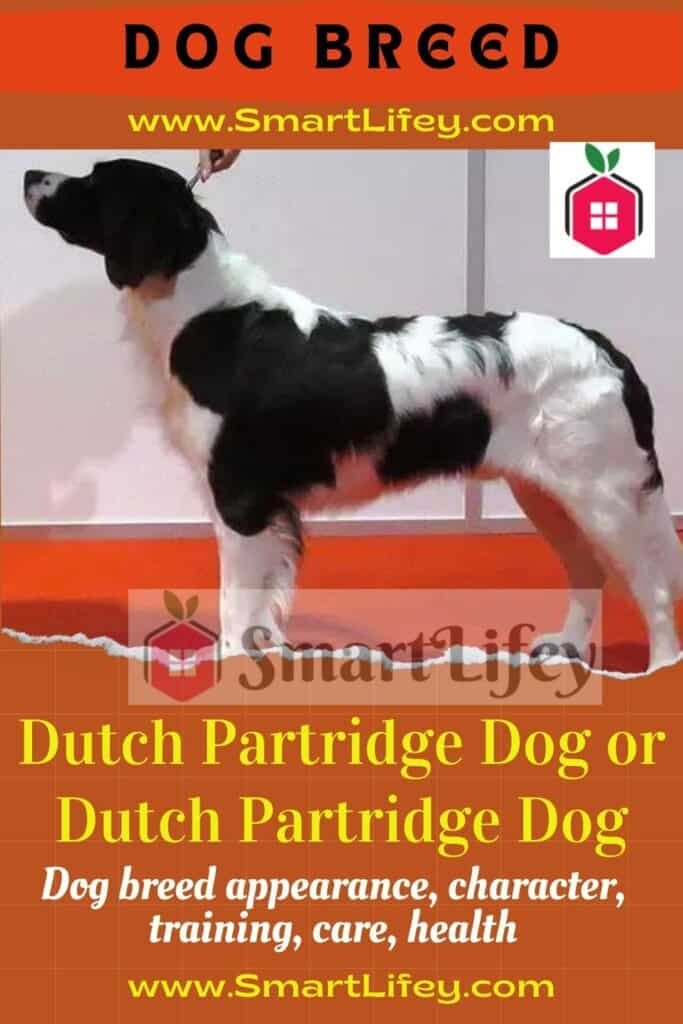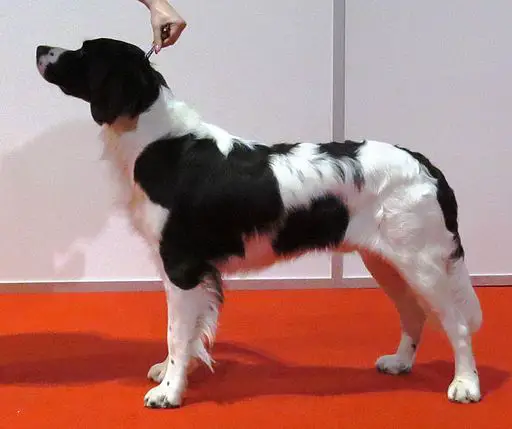
The race retriever Drenthe is a dog with character, hardworking, patient and persevering docile. Intelligent and gentle, it is very affectionate. Regarding its physical characteristics, it is slim, but muscular and well proportioned. It is a modern, versatile, quiet and clean pet, ideal for almost all types of families. At Petlifey, we explain everything about the Drenthe Dog.
Character of the Dutch Partridge Dog breed
The Dutch Partridge Dog has a loyal and intelligent character, it is a valuable companion for the hunter, since it adapts to all types of terrain and prey. Hunt within the shotgun’s firing range and spin its tail as it follows the trail.
It waits for the hunter near the collected prey and, if the hunter is delayed, look back to see what happens to them. It knows how to find and collect lost prey well. As they are all innate characteristics, little training is required. It is also highly esteemed as a family dog for the sweetness of its temperament.
Despite its great racial purity, the Dutch Partridge Dog has common traits and a more than likely family bond with other dogs such as the French Spaniel and the Munsterlander, and, like them, it is an excellent hunting dog.
Its behaviour is ideal for those who want to enjoy a quiet hunt, without haste, in all types of terrain and with all types of pieces, they will find in this dog what they are looking for.
It is capable of hunting without ever losing sight of its guide, without straying too far, and without reaching the piece so far in advance as to cause it to flee while it is still out of range of the shotgun.
It never rushes and its sample is firm and clear, allowing the hunter to act in sequence.
And last but not least, this animal is a skillful and solicitous collector who diligently picks up the pieces regardless of whether they have fallen into the undergrowth or even into the icy waters in winter.
- Energy: high. It is a dynamic, active and energetic animal that needs to exercise daily, not only with walks but also with running and outdoor activity.
- Temperament: loyal and intelligent character. It is also highly esteemed as a family dog for the sweetness of its temperament.
- Adaptability: medium / High. It adapts well to almost all environments as long as it is allowed to exercise.
- Sociability: high. It is devoted to its family, which it loves to be surrounded by, and it gets along especially well with children, with whom it becomes its inseparable playmate.
- Health: good. You may have joint problems.
- Longevity: medium / High. Live about 12 years.
- Utility: versatile. It is an excellent hunting dog and a great guardian and companion animal.
- Use: hunting, guarding and company.
Characteristics of the Dutch Partridge Dog
The Dutch Partridge Dog has well-defined physical characteristics. It is a well-proportioned dog, muscular, slim and with well-defined lines, whose powerful body is the proof of its great ability to develop the necessary speed in a hunting dog.
It is longer than tall, robust, of great strength and powerful musculature, but it presents at the same time an agile and light appearance and profile characteristic of dogs perfectly adapted to hunting tasks. Let’s see in more detail what the Front retriever looks like and the breed standard :
- General appearance: it is a well-proportioned, muscular dog with a well-defined cut structure that denotes power.
- Size: large.
- Height at the withers: between 58 and 65 cm for males and between 55 and 62 cm for females.
- Weight: between 20 and 25 kg for males and between 19 and 24 kg for females.
- Origin: The Netherlands.
- Other names: Drentse Patridge Dog / Épagneul á perdrix de Drente / Drent’scher Hühnerhund / Drentse Patrijshond.
- Body: with a robust complexion, it has a slightly elongated structure and powerful musculature. The dorsal line is straight and almost horizontal. The loin is muscular
- Head: it is broad and slightly domed.
- Skull: in the midline it has a scarcely visible groove from the stop to the middle of the occipital protuberance, which is poorly developed.
- Muzzle: it is somewhat shorter than the skull, wedge-shaped and truncated at the end, with a wide muzzle.
- Nose: well developed and brown in color. Its nostrils are wide open.
- Eyes: they are widely separated, are of medium size and oval in shape. They have a beautiful amber color, medium hue, neither light nor dark. They are neither sunken nor protruding. Your eyelids are well attached to the eyeball. Its expression shows the good-natured and intelligent character of this Hunting Dog.
- Ears: set high, close to the cheeks without forming folds, wide at the start and blunt at the tip. They are mobile and express the different moods of the dog. For example, when it is attentive, it bends them forward and lifts them. They are covered by abundant long wavy hair, although it is shorter at the ends.
- Nose-frontal depression (stop): hardly marked.
- Jaws: has strong teeth and has a regular and complete scissor bite.
- Neck: it is strong, of medium length, and describes a continuous and flowing line between the head and the trunk.
- Chest: deep and broad, reaching up to the elbows; the rib cage is long and the ribs are well developed and tight.
- Back: straight and of medium size, although the rump is wide and long, with a slight inclination.
- Forelimbs: good bone, muscular but lean structure. Shoulders: Long shoulder blades, well set back, positioned so that the shoulder, arm and forearm are well angulated. The forearms are straight and muscular. Their elbows are close to the chest, not looking out or in, so they do not limit the dog’s movement.
- Hind limbs: well developed, broad and muscular. In its legs, the set of bones of the pelvis, the thigh and the leg have good angles to each other. Seen from behind, the hind limbs are straight and fall in an absolutely vertical position. The knees are well angled and the hocks are close to the ground.
- Feet: rounded or oval in shape, with tightly knit, arched and strong toes, with solid pads.
- Tail: set quite high, at rest reaches the hocks. The dog, in action, carries it horizontally, with the final third gently arched upwards. Covered with abundant hair forming fringes, which are shorter at the end.
- Skin: smooth and close to the body.
- Hair: it is dense wavy but not curly and covers the body well. It gives the impression of having long hair, when in reality it is not exactly like that, although in some parts such as the neck and the windowsill it is long. It has fringes on the ears, as well as on the back of the thighs and legs. Except at the base, the tail is covered with fringes that taper towards the tip.
- Color: white with brown markings, with or without specks. The ears and hair around the eyes are brown.
- Movement: The step is energetic and harmonious, but at the same time covers a lot of ground. When trotting, the limbs do not move too close together or too far apart; without wobbling or deflecting the elbows or lukewarm-tarsal joints outward. As you increase your speed, you tend to seek the middle line.
- FCI Classification: FCI # 2 GROUP 7 Pointing Dogs – Section l Continental Pointing Dogs.
Dutch Partridge Dog puppy
If you are considering adopting or buying a Dutch Partridge Dog puppy, there are certain aspects that you should know before taking the final step. In this way, both you and your pet will mutually enjoy each other.
The puppies of this breed are very curious due to their hunting instinct. For this reason, it is interesting to start the process of education and / or training as a young person. If you have other types of pets at home, such as cats or birds, it is advisable to accustom the puppy to their presence from a young age and so that it learns to live with them.
It is an ideal family dog, although today it is still a very local breed. However, it has a great projection and those who are interested in the breed will find their reward in the effort of looking for a good breeder of this breed.
Education and training of the Dutch Partridge Dog
Educating a specimen of this breed is quite simple thanks to its great intelligence and dedication that it professes for its masters. Even so, it is advisable for more inexperienced owners to seek the advice of experienced breeders or trainers to help them answer any questions.
On the other hand, it is a dog that adapts well to all lifestyles, as long as it guarantees the exercise it needs, because it is not enough to give it a good daily walk, also take it from time to time to a limited and safe area so I can run.
Feeding of the Dutch Partridge Dog breed
Regarding the diet of the Dutch Partridge Dog, it is a dog that needs a good caloric intake to be able to perform its function effectively and maintain its muscles and joints.
But special care must also be taken so that the dog does not gain weight, since if it lives in a home and does not have a lot of daily activity, it may have a tendency to obesity. The daily intake of dog food can be divided into two doses.
In the same way, it is essential to offer them quality croquettes or feed. That it provides you with quality healthy proteins and fats to keep your health and body in perfect condition.
Whether in specialized pet stores or online, it is not difficult to find food for this type of dog.
Health and diseases of the Dutch Partridge Dog
Regarding the specific diseases of the Dutch Partridge Dog and its health, it is a healthy dog, with very few serious problems associated with the breed and that does not require specific aesthetic adjustments.
In fact, fans of this breed have remained faithful to the philosophy of seeking and maintaining its qualities over aesthetic preferences, which has meant a utilitarian selection that has given priority to temperament and health over any other aspect.
Likewise, it is essential to go to the veterinarian at least twice a year to monitor its health, apply the necessary vaccines, as well as carry out an external and internal deworming program. It is the only professional who can take better care of your veterinary care than anyone else.
Specific care of the Perdiguero breed

Despite having a beautiful coat, its maintenance is very simple, since it is reduced to a good brushing every two or three days to eliminate dead hair and prevent tangles from occurring.
If you wonder how often can the Dutch Partridge Dog be bathed ? The answer is that it is advisable to bathe the dog only when it is really dirty. You must do it with a special shampoo for dogs and rinse it well, making sure not to leave product residues on their hair.
